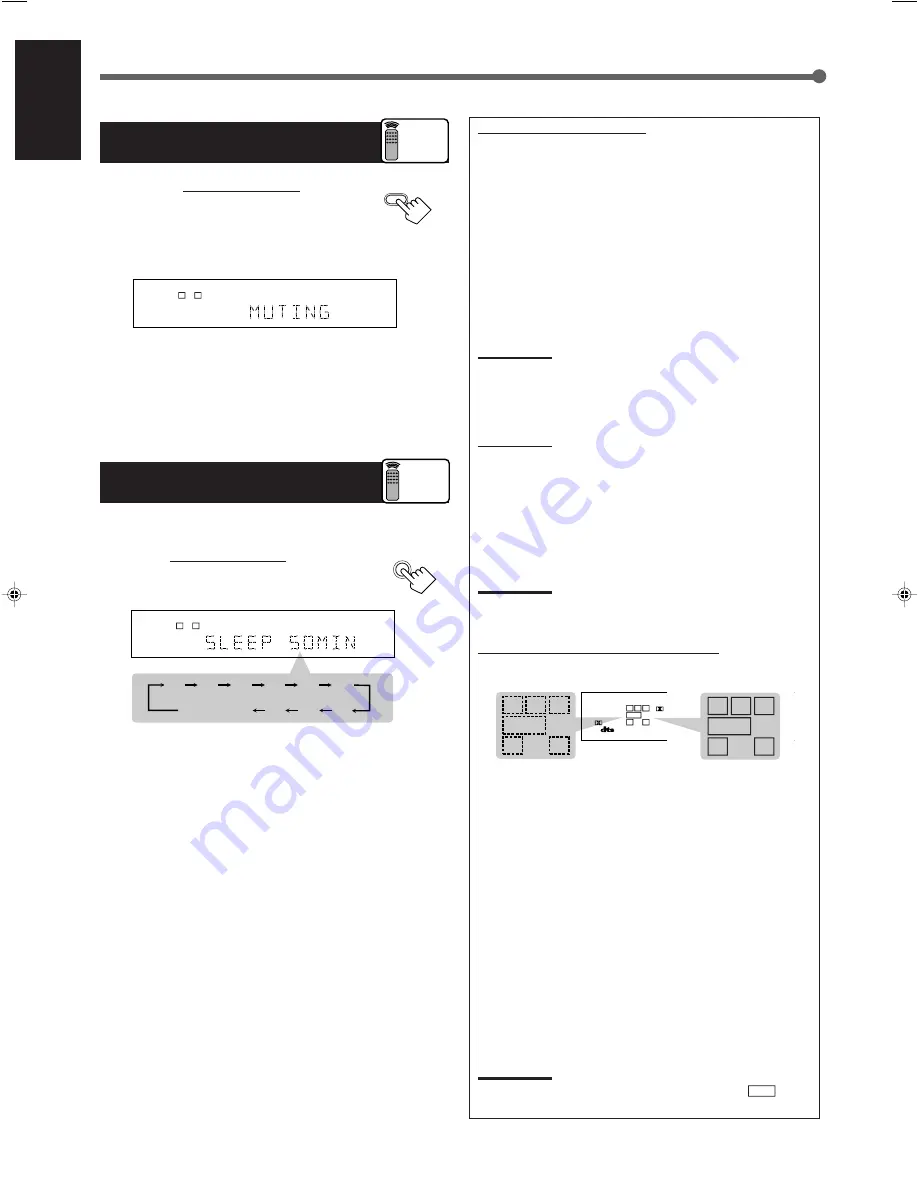
10
English
Basic Operations
Turning Off the Sounds
Temporarily—Muting
Press MUTING
on the remote control
to mute
the sound through all speakers and headphones
connected.
• “MUTING” appears on the display and the volume
turns off (the volume level indicator goes off).
To restore the sound,
press MUTING again.
• Turning MASTER VOLUME on the front panel or pressing
/– on the remote control also restores the sound.
Turning Off the Power
with the Sleep Timer
You can fall asleep while listening to music—Sleep Timer.
Press SLEEP
on the remote control
repeatedly.
• The SLEEP indicator lights up on the display, and the
shut-off time changes in 10 minutes intervals.
When the shut-off time comes
The receiver turns off automatically.
To check or change the time remaining until the shut-off time
Press SLEEP once.
The remaining time (in minutes) until the shut-off time appears.
• To change the shut-off time, press SLEEP repeatedly.
To cancel the Sleep Timer
Press SLEEP repeatedly until “SLEEP 0 MIN” appears on the
display. (The SLEEP indicator goes off.)
• Turning off the power also cancels the Sleep Timer.
L
C
S.WFR
LS
RS
CH-
S
LFE
SPK
ANALOG
R
MUTING
Remote
ONLY
Remote
ONLY
SLEEP
20
10
30
40
50
60
70
80
90
(Canceled)
0
L
C
S.WFR
LS
RS
CH-
S
LFE
SPK
SLEEP
ANALOG
R
Basic adjustment auto memory
This receiver memorizes sound settings for each source when:
• you turn off the power,
• you change the source, and
• you assign the source name.
When you change the source, the memorized settings for the
newly selected source are automatically recalled.
The following can be stored for each source:
• Input attenuator mode (see page 15)
• Balance (see page 15)
• Tone adjustment (see page 15)
• Subwoofer output level (see page 15)
• Surround mode selection (see pages 21 – 23 )
Notes:
• You cannot assign and store different settings for digital input
mode and analog input mode.
• If the source is FM or AM, you can assign a different setting for
each band.
For recording
You can record any sources playing through the receiver to a
cassette deck (or a CD recorder) connected to the TAPE/CDR
jacks and the VCR connected to the VCR jacks at the same time.
While recording, you can listen to the selected sound source at
whatever sound level you like without affecting the sound levels
of the recording.
Note:
The output volume level, tone adjustment (see page 15), and
Surround modes (see page 18) cannot affect the recording.
Signal and speaker indicators on the display
The following signal indicators light up—:
L
: •
When digital input is selected:
Lights up when the left
channel signal comes in.
•
When analog input is selected:
Always lights up.
R
: •
When digital input is selected:
Lights up when the right
channel signal comes in.
•
When analog input is selected:
Always lights up.
C
:
When the center channel signal comes in.
LS :
When the left rear channel signal comes in.
RS :
When the right rear channel signal comes in.
S
:
When the monaural rear channel signal or 2 channel Dolby
Surround encoded signal comes in.
LFE:
When the
LFE
channel signal comes in.
The speaker indicators light up when both of the following
conditions satisfied:
• The corresponding speaker is activated, and
• The corresponding speaker is required for the current playback.
Note:
When “SUBWOOFER” is set to “YES” (see page 12),
S.WFR
lights
up.
S.WFR
LS
RS
S
LFE
R
C
L
L
C
S.WFR
LS
RS
CH-
S
LFE
SPK
ONE TOUCH
PRO LOGIC
ΙΙ
DIGITAL AUTO
ANALOG
DIGITAL
LINEAR PCM
R
S.WFR
LS
RS
S
LFE
R
C
L
Signal indicators
Speaker indicators
EN08-17.RX-5020/5022V[C]_f
01.12.27, 10:11 AM
10
















































